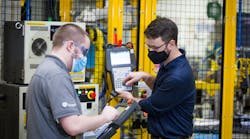As smart manufacturing becomes further embedded into production facilities, employees staffing these digital plants must have specific skill sets. What GE Appliances (GEA), a Haier company, which has invested $1 billion over the past five years to create its digital environments, discovered is that many recent engineering graduates do not have the skills needed to operate the nine smart manufacturing facilities that the company operates.
So, they created a program -- The Industry 4.0 Development Program -- to fill that knowledge gap.
“To help us operate advanced automated equipment, we need people who understand it and can ensure it’s designed correctly to fit into our digital environment,” said Trent Ingrim, senior director – Advanced Manufacturing/Industry 4.0 for GE Appliances.
The program, which spans a two-year period, is comprised of four technical rotations in industrial controls, robotics, testing and data visualization. The program is designed for people with degrees in computer science engineering and mechanical engineering or graduates of mechatronic programs.
The four rotations include:
1. Industrial controls – The machinery in today’s modern plants is complex, with industrial and electrical controls that need to be programmed, including human-machine interfaces (HMIs) or touch screens, PLCs or program logic controllers that make the machine work. In addition, there are many safety controls, such as light curtains and area scanners, to ensure nothing comes in contact with the operator that may pose a safety hazard while the equipment is operating. During this rotation, program members participate in original equipment manufacturer (OEM) design reviews and run-offs to learn how to ensure the equipment is compatible with GEA’s digital plant environment.
2. Robotics –The rotation after industrial controls is robotics. Participants learn to incorporate the use of robots and other types of controls to work with the equipment – including the use of vision or cameras to drive expanded flexibility and capabilities in the factories.
3. Test group – The third rotation is focused on testing with a twist from the past. The GEA team decided it would be a strategic advantage to create software and programming in-house for test systems and equipment, which has been a “resounding success” with first-pass yields up as much as 10%. The improved data is being reported or fed into the company’s Brilliant Factory data visualization system. To finish out the rotation, participants develop competencies in high-level programming and database use.
4. Brilliant Factory – In the fourth and final rotation, participants continue to develop and refine GEA’s factory data visualization tool – Brilliant Factory – bringing new features to the platform on a weekly basis.
“This training will close that gap between the theory that students were taught at universities and the systems that are currently being used in manufacturing facilities today,” says Ingrim. “Technology changes very quickly and many students haven’t had the opportunity to train on these systems.” Ingrim gives a specific example. “You have a lot of people that can are adept with 3D printers, but not very many that are able to work with industrial controls, robotics, or vision systems and quality systems that we are working with today.”
To help the academic sector understand the extent of this gap, Ingrim has been working with the University of Michigan and Virginia Tech on curriculum changes they need to consider.
And one of the fundamental changes that universities need to consider is the philosophy of how they teach, says Dean Christopher Pearson, Ph.D. Dean, College of Innovation & Technology at the University of Michigan (Flint campus). “Academia has not been really great at fostering innovation,” Pearson explains. “For hundreds of years we have been giving out grades and in order to get the top grades, students do the safe thing. Instead, we need to develop ways that let students try things that are innovative. And they may fail. We're not saying we want to fail just for failure’s sake, but we need to provide an environment where they can feel safe enough that they can try something innovative and perhaps fail. We have to instill in people that learning is a lifelong journey.”
And that type of learning is critical to GEA's program, which is much more experiential hands-on learning than is found in a theoretical engineering program. “We need to develop skills in collaboration, critical thinking because the machines are going to do things better and faster and with fewer errors so we have to work that into our, our curriculum as well," says Ingrim.
Designing these machines and working alongside them, is exactly what Ingrim sees happening at GEA. “In 18 months, we have installed about 100 robots, but we have still hired about a thousand people during that time.”
Hiring and training will occur simultaneously at GEA. While The Industry 4.0 Development Program had its first graduate in April, Collie Crawford, Ingrim sees this program growing quickly. “We have a roll up your sleeves and get to work philosophy here and we approach all challenges through that lens. Offering hands-on experience will provide employees with the tools they need to be successful and help us create a successful future.”
Photo: Two employees on the Industry 4.0 Development program – Jordan Klotz ( left) and Collie Crawford ( right) discuss shortcuts for “pick and place” routines on the robots teach pendant for the new automated dishwasher spray arm assembly cell.




